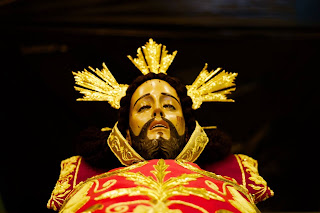Señor Santo Sepulcro de Paco - The Lord of Paco, Manila
 |
| Señor Santo Sepulcro de Paco |
The Señor Santo Sepulcro of Paco gained much following over the centuries and despite the passage of time, this devotion became one of the most enduring in these times and continues to garner more devotees up to the present.
The Visage of the Lord of Paco
The revered image of the Señor of Paco is that of an image of the dead Our Lord Jesus that was laid in the Holy Sepulchre. The revered image of the Santo Sepulcro is laid down with beautifully embroidered sheets to cover the body offered by devotees over the years.
Despite of the fact that it is the image of the dead Christ, his symbols of divinity is still depicted in this image with the presence of Tres Potencias attached to his head and still have that serene look, waiting for his resurrection three days later. The image is enshrined in his own altar in the gospel side of the church and encased in a beautiful calandra that was recently restored in 2017.
Origins
 |
| Estampa of Señor Santo Sepulcro de Paco |
Although the Parish of Dilao is named after St. Ferdinand of Castille that was adopted by the Franciscans and was formerly dedicated to Nuestra Señora de Candelaria, it is the Señor that enjoyed much devotion and veneration in the area for centuries.
The origins of the famed Señor were unknown due to scant records about it's arrival or carving yet there was an oral history that is known in Paco-Dilao area that tells the image's beginnings. It is said that when the Parish of Paco was set to be dedicated to St. Ferdinand III, King of Spain sometime in the 1500's yet they could not find nor commissioned an image of San Fernando that time that the people used an image of Señor Santo Sepulcro instead for the dedication rites.
The enshrinement was somehow providential for the Señor Santo Sepulcro began to manifest miracles to his devotees over the years from the elites to the masses of the district. The existence of numerous antique estampas and devotionals bearing the image of the Señor that dates back to the Spanish era would attest to the prominence of the devotion in Old Manila. The image of the Señor, together with the image of Nuestra Señora de Candelaria was recently restored to it's former glory in 2017 by the Atelier of Dr. Raffy Lopez that took place under the administration of Msgr. Rolando de la Cruz, the current parish priest of Paco Church.
 |
| Senor Santo Sepulcro de Paco |
Like the famed Nuestro Padre Jesus Nazareno of Quiapo, the image of the Dead Christ is still visited by devotees who consider Him as the Last resort for help and solution to problems involving sickness, financial difficulty and everyday life struggles.
One of the most notable miracles of the Señor of Paco that was well known to the devotees is when there was a certain old beggar who would roam around the Calle "Ulilang Kawayan" and the residents mocked the old beggar by giving him broken plates and utensils. The following day, the people of Ulilang Kawayan were surprised that they saw the broken plates and utensils on the image of the Señor upon looking on the face of the image, they recognized that it was the beggar who visited the area. The residents of Ulilang Kawayan immediately asked forgiveness to the Señor for their actions and it is said that when procession of the Señor passes by Ulilang Kawayan, the andas of the Señor becomes unusually heavy as a reminder of the mockery he received from the residents.
The devotion
 |
| Señor Santo Sepulcro de Paco inside his calandra |
As of this writing, pilgrims and devotees still flocked the Paco Church to ask the Señor for his untiring help in their needs. The image of the Señor comes out from his shrine twice a year, first on Good Friday for the Burial Procession and second on the Eve of the Fiesta of the Señor that falls on a Saturday. The fiesta of the Señor was originally celebrated every August 19 yet considering that the date may fall on a weekday where most of the populace were at work or in school, it was decided to be moved to Sunday after August 19 if the said date will not fall on a Sunday.
The devotion to the Santo Sepulcro is quite unique in our country where in our culture that has a unique way to remember our faithful departed, it was also manifested through this unique devotion to the Dead Christ. The devotion to the Señor teaches us that death that was then the end result of our sins became our passageway to our eternal reward when Christ rose from the dead and broke death's original purpose.
O Señor Santo Sepulcro de Paco, kaawaan mo po kami!
Reference:
Castro, Alex (2016), The Santo Sepulcro of Paco in Art, Retrieved from http://andalltheangelsandsaints.blogspot.com/2016/11/274-santo-sepulcro-of-paco-in-art.html on November 6, 2018.
Darang, Josephine, (2006), A Purely Personal book of Miracles: A Collection of Columns published by Philippine Daily Inquirer, Sound Publishing Corporation, Makati City.
Interview:
Cofradia ng Mahal na Poon ng Santo Sepulcro, San Fernando de Dilao Parish, Paco, Manila.
Special thanks to the Cofradia ng Mahal na Poon ng Santo Sepulcro of San Fernando de Dilao Parish, Paco, Manila for the necessary information that were used for this blogpost.
Credits to the owners of the photographs of the Señor of Paco that were used for this bogpost. +AM+DG+





Comments
Post a Comment